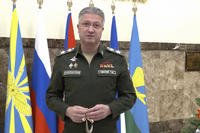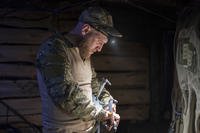Defense officials said Wednesday that they've invited the Army to join what had previously been an exclusive club for naval and air power as DoD stands up a new office dedicated to its elusive "Air-Sea Battle" concept.
The officials, who briefed reporters at the Pentagon under ground rules they not be named, said former Secretary Gates' original mandate for "Air-Sea Battle" only went to the Secretaries of the Navy and Air Force. But now "We are actively seeking to pull the Army onboard so we can be a four-service office," one official said.
As a quick update for your PowerPoint org chart, the defense officials said the Air-Sea Battle Office would comprise about 15 total people reassigned from the services. A separate Pentagon announcement said it would include "a minimum of two field grade officers or civil-service grade equivalents" from the Air Force, Navy and Marine Corps -- but the written announcement did not mention the Army.
At any rate, Wednesday's defense officials said they wanted their office to become "a focusing lens" to help the services deal with tomorrow's problems of anti-access and area denial -- wherever they occur. The three officials did rhetorical backflips to avoid saying the word "China," insisting they wanted their work to be applicable in any operational theatre.
Their profusion of buzzwords and jargon; their reluctance to define exactly what "Air-Sea Battle" is; and their refusal to talk in concrete terms left several reporters scratching their heads as to what exactly the briefers were talking about.
"Air-Sea Battle is not a war plan, not a [conops] plan, not an operational plan, it’s a framework of design which articulates and describes what the problem is," one official said.
To that end, the new office will "Facilitate inter-service and inter-agency coordination during the development of the concept, supervise the implementation of ASB-related training, manning and equipping; and manage the executing the ASB concept," the official said.
In other words: Air-Sea Battle is Air-Sea Battle, and the Air-Sea Battle Office will be charged with promulgating Air-Sea Battle. Simple, see?
The existence of a permanent new joint office, planned as a kind of running dormitory bull-session for the services, represents a shift in the bureaucratic trajectory for "Air-Sea Battle." At first, it was apparently planned as a discrete document, a paper report that would define the Navy and Air Force's strategies for dealing with China's advanced new weapons in the Western Pacific. The unspoken subtext was that it would justify pricey Air Force and Navy programs, as the services ostensibly drew closer and even exchanged traditional missions.
One defense official said Wednesday that there may or may not be a document like this at some point, but there is no schedule for when anything might appear inside the Pentagon or be sent to Congress. Standing up an office may have been an internal compromise to delay or kill the appearance of a report, while still making permanent the inter-service analysis that Gates and now Secretary Panetta evidently want.
Service officials have told Congress before that "Air-Sea Battle," the strategy, was finished and awaiting Panetta's signature or endorsement, but Wednesday's briefers were very vague on that point. Panetta "has acknowledged the work as credible work and has given us the green light to move forward with implementation of Air-Sea Battle," one defense official said. It was not clear whether the existence of the office meant Panetta had rejected an existing report or strategy, or been so pleased with it he directed its authors to go to work permanently.
As the briefers described it, the people in the Air-Sea Battle Office are effectively emissaries from their own services' strategy hubs -- the Marines will be ambassadors from Quantico, the airmen from Dayton and the sailors from Norfolk. (Just where the pending Army officers should come from could become a new parlor game -- or fistfight -- on the green side. Then again, this is already so arcane the Army may not care.)
Wednesday's briefers said one goal is for the ambassadors to return to their respective stovepipes Cylinders of Excellence and spread what they've learned about the other services. In one of very few concrete examples, a defense official cited the danger that small swarming boat attacks pose to Navy warships. Air Force planners don't necessarily know about that, but the joint office could help them understand it.
A questioner asked whether the office would consider ideas such as a Naval War College concept in which Air Force A-10 Warthog tank-killers helped with that Navy swarm threat. Air Force and Navy commanders traditionally might not have thought to use the aircraft this way, but the A-10s' pulverizing main guns could shred attackers while they were safely away from friendly ships.
"Yes," said one of the defense officials. But the officials would not go into detail or volunteer any of their own examples about how the services could work together in a future conflict.
"There’s a large portfolio of U.S. capabilities. There are many combinations," the official said.
A study last year by the Center for Strategic and Budgetary Assessments included a few recommendations that, at the time, were said to be close to DoD's actual considerations, but were never officially confirmed. One suggestion of the CSBA report was that Navy Aegis warships could protect U.S. air bases in the Pacific from Chinese missile attacks -- for instance, a cruiser might lay off Okinawa, from which it could quickly re-arm, and defend the Marine base there with radars and missiles not originally intended for such a task.
Another suggestion was that Air Force bombers could lay offensive sea mines, taking a traditional Navy role to free up attack and guided-missile submarines in a conflict in the South China Sea.
Which brings us to the new inflection point for "Air-Sea Battle:" When Pentagon officials first began talking about it, the plan was seen as a way to justify starting or prolonging weapons programs in order to solve anti-access and area-denial problems. The Air Force needed a stealthy new bomber to drop those mines -- and it needed the mines -- just as the Navy needed stealthy new long-range unmanned strike aircraft to fly off its carriers.
With an Air-Sea Battle Office, as opposed to an Air-Sea Battle Report, DoD seems to have backed off that strategy, or elected to pursue it by a more circuitous route. The defense officials Wednesday said their work will trickle out across the Corporation, including to program offices, so it still could influence the Air Force's bid to get a bomber, or the Marines' new amphibious vehicle, only less directly.
"Those discussions are happening," one official said. "We don’t have direct control of resources, or direct authority – we help facilitate those things, we help put the spotlight on certain issues ... we will help ensure those conversations happen."








